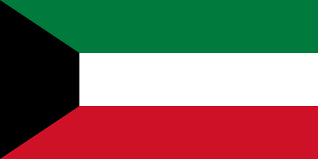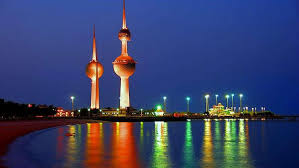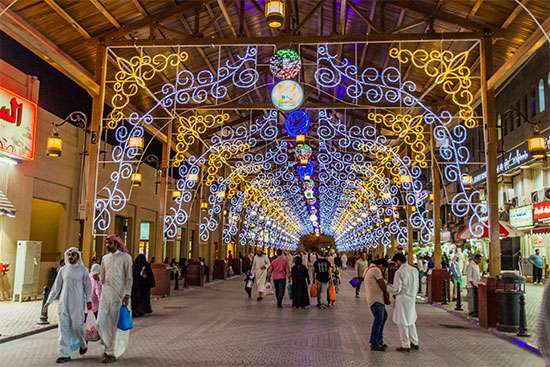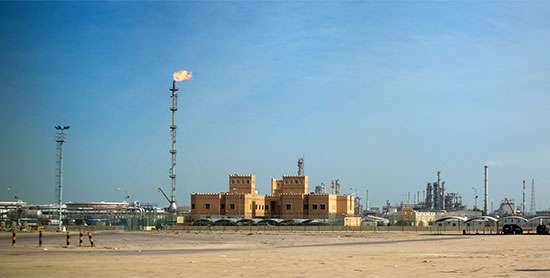The Kuwait is a country located in the Arabian Peninsula in Western Asia which borders with Iraq and Saudi Arabia. It has a territory of approximately 18 thousand km² and a population of about three million inhabitants. Its capital is Kuwait City and the official language is Arabic. It has a high Human Development Index .
Kuwait Flag

The flag of Kuwait is the official national flag of this emirate located on the Arabian Peninsula. The symbol has three horizontal bands of the same size in green, white and red. On the side of the mast, a black trapezoid is placed over the stripes. This flag represents pan-Arab colors.
Previously, the territory of Kuwait was occupied and populated by different empires and occupying powers. In the 7th century, Islam came to this area, with the Rashidun caliphate. The flags used until then corresponded to these empires.
Kuwait’s conception as an emirate emerged in the 17th century. Soon after he started using a red flag as a symbol. It was not until the 20th century, when Kuwait began to have its own flags, until it promulgated independence in 1962. This is the same flag that remains in force.
In addition to pan-Arab colors, green represents Kuwait’s fertile land. Black is identified with the defeat of enemies in battles, while red represents blood and spilled swords. Finally, white is identified with purity.
Flag History
Kuwait’s conception as a separate political entity is historically recent. However, the population of its territory is much older. Mesopotamians were established on the island of Failaka in approximately 2000 BC. The Dilmún civilization occupied the shores of the Bay of Kuwait until the beginning of the growth of piracy, around 1800 BC
Achaemenid Empire
Around the 5th century BC, Cyrus the Great founded the Achaemenid Empire. This was expanding across the Middle East, including Kuwait. The monarch had an important flag. Its predominant color was garnet and a yellow bird was imposed on it
Origins
The region where the territory of Kuwait is today was colonized by the Greeks in the 3rd century BC, where they believed that Icarus, a mythological son Daedalus known for trying to let Crete fly, was buried. Over the following centuries, the region witnessed the presence of many empires and the intense dispute between different ethnic groups.
Domination
In addition to the rule of the Greeks that began in the 3rd century BC, the Kuwait region was under the rule of other great empires that marked the history of the Middle East. After the Greeks, the region was dominated by the Parthian Empire, which is also called the Arsacid Empire and was one of the main Iranian political and cultural powers in ancient Persia. At its peak, the empire dominated a territory that stretched from the banks of the Euphrates River to the east of Iran, dominating the Silk Road, an important trade route between the West and the East at the time. Later, the region came under the control of the Sassanid Empire, which was the last pre-Islamic Persian empire. It was one of the main powers in West and Central Asia and one of the most influential. At that time, the region of present-day Kuwait was known as Hajar. Later,with the conversion of the region’s population to Islam, the territory of Kuwait became part of the Islamic caliphate.
Formation of Kuwait
The term Kuwait is the diminutive of kut, which means strong. That is, strong. The first permanent settlers in the region came from the Bani Khalid tribe and it was they who established the state of Kuwait. This was founded in the early 18th century, bringing together several clans from the Anaiza region, resulting in the miscegenation of migrants. After several displacements, these peoples found a pleasant place to live and joined the Bani Khalid tribe. Progressively, Kuwait became a central point of trade and benefited from its favorable position. But, as in every region, Kuwait came under the influence of the Ottoman Empire in the late 19th century. Although the Ottomans recognized the autonomy of the al-Sabah dynasty, they claimed sovereignty over Kuwait.The growing interest of European countries in the dispute over consumer markets and areas of influence in the East caused Kuwait to approach the United Kingdom at the end of the same century. The Arab country gave control of foreign policy to the British in exchange for protection and subsidies. The beginning of the 20th century marked the intensification of international tensions in market disputes, which was accompanied by other political problems resulting in the First World War. The conflict extinguished the Ottoman Empire, generating several independent states in the East. Kuwait became an independent principality protected by the British Empire. In the 1920s and 1930s, Kuwait became one of the poorest countries in the world because of the collapse of pearl collection in the Persian Gulf, which ruined its economy.The dependence grew even more in relation to the British, who enjoyed perks and privileges in their territory.
Contemporary Kuwait
Kuwait became fully independent on June 19, 1961, ending the perks of the British. Soon thereafter, oil stations were discovered in the region, which caused a large investment of resources in the country, reflecting the enormous growth of the oil industry, responsible for transforming Kuwait. The country ceased to be a poor producer of pearls and became one of the richest in the Arabian Peninsula in a short time, attracting many workers from Egypt and India. Kuwait’s independence and economic strength were recognized by Arab neighbors during the 1960s. But after the nationalization of the country’s main oil company in the 1970s, Kuwait suffered from a serious economic crisis in 1982. In that At that time, there was a severe oil crisis, which began in 1979,which caused great damage on a global scale. Although it lasted a short time, it was enough to cause a lot of damage. But Kuwait was constantly increasing its production, filling the gaps left by Iraq and Iran in oil production.
At the time of the war between Iraq and Iran, Kuwait provided Iraq with economic aid. At the end of the conflict, Iraqis asked for debt relief of more than $ 65 million, which was rejected by the Kuwaitis. Thus, an economic dispute arose between the two countries that grew gradually. Kuwait continued to increase its oil production and Iraq accused it of abusing exploration rights. Under Saddam Hussein, Iraq invaded Kuwait in August 1990 and installed its own governor. The Iraqi occupation caused the death of more than a thousand civilians and the flight of more than 300 thousand inhabitants. The United States led an international coalition that brought together 34 nations and faced the Iraqi army in the second Gulf War. Thus, in February 1991, the Americans managed to expel Iraqis from Kuwait.But before leaving, the Iraqi army damaged 737 Kuwaiti oil wells, destroying about 5 million barrels of oil. With all the destructive actions by Iraqis, Kuwait spent more than $ 50 billion to rebuild its existing structure before the invasion. Once again, however, Kuwait has demonstrated its capacity for recovery, returning to good socioeconomic and environmental conditions. The country has diversified its production and exports by establishing strong trade ties with Japan, the United States and the European Union, for example. Today, Kuwait is one of the richest countries in the world, with an economy that grows considerably.Kuwait spent more than $ 50 billion to rebuild its existing structure before the invasion. Once again, however, Kuwait has demonstrated its capacity for recovery, returning to good socioeconomic and environmental conditions. The country has diversified its production and exports by establishing strong trade ties with Japan, the United States and the European Union, for example. Today, Kuwait is one of the richest countries in the world, with an economy that grows considerably.Kuwait spent more than $ 50 billion to rebuild its existing structure before the invasion. Once again, however, Kuwait has demonstrated its capacity for recovery, returning to good socioeconomic and environmental conditions. The country has diversified its production and exports by establishing strong trade ties with Japan, the United States and the European Union, for example. Today, Kuwait is one of the richest countries in the world, with an economy that grows considerably.for example. Today, Kuwait is one of the richest countries in the world, with an economy that grows considerably.for example. Today, Kuwait is one of the richest countries in the world, with an economy that grows considerably.
The Al-Mubarakiya Souk is Mercadão of Kuwait City. There you can find typical clothes, such as the abaya (reminiscent of a long and wide female dress, like a cape that is placed over the clothes) and the dish dash (long male dress), as well as scarves, rugs, perfumes, souvenirs, sweets, teas and chocolates are displayed in small stores and stalls around the market.
The incenses are intensely fragrant and are part of Kuwaiti culture, present throughout the city. They have an unmistakable and intoxicating aroma, mostly based on sandalwood. At the Souk, they are sold in stalls; in hotels and other public places, they are burned in droves to purify the air and reduce the smells of food and cigarettes. Kuwaiti men and women also use it as a perfume.
Outside the Souk, there are cafes and restaurants, with a wide variety of foods , influenced by Mediterranean Mediterranean cuisine and Indian and Asian cuisine. You eat very well in the Gulf country. Those who like Arab food will be delighted with an abundance of hommus, babaganoush, curd, Arab breads, lamb, chicken (Brazilian) and beef, salads, rice and sweets, all very fresh and tasty. The quality of Kuwaiti food is excellent almost anywhere, as local health surveillance is very strict.
The alcohol is prohibited in the country, offering options like juices of fruits, camel milk, yoghurts and drinks without alcohol. Black tea and Arabic coffee (the one with cardamom) are found almost everywhere.
The most popular meeting place among Kuwaitis at the moment is the cafeterias , a great success among young people in the city. In them, you can find the types of coffee that our palate recognizes more easily, such as espresso, strained and the French press. The origin of the grains? Brazil, Ethiopia, Honduras and Panama are among the exporters. In some cafeterias (like the one in the photo in the gallery) it was possible to see the bags of Brazilian coffee on display, decorating the environment.
The Jaber Al-Ahmad Cultural Center is a tour for the whole family, with concert and opera rooms, restaurants and other attractions. The ultramodern buildings, with lots of glass and steel, are inspired by Islamic architecture, with arabesques, and seem to fit into the landscape near the beach. The site was designed by English architect Ray Phillips and opened a year and a half ago. Orchestras, operas and artists from different parts of the world have passed through there. Every half hour, there is a water show, with a fountain that seems to dance to the rhythm of Arab music.
The Museum of Modern Art in Kuwait is housed in an old house, with traditional Arabic architecture, with a large courtyard in the middle. The site housed one of the oldest and most prestigious schools for boys since 1938 – Emir Sabah Al Ahmad studied there – until it was converted into a museum in 2003. During the visit, there were three exhibitions on display. One showing “before and after” photos of the bombings in Iraq, and the others of paintings by Iraqi artist Maher Al-Taee and Armenian artist Jackie Kazarian.
The Kuwait Towers are a beautiful postcard of the city, opened in 1979 as a landmark and symbol of the country’s modernity. During the day the three towers (there is a small one that can only be seen during the day) are bluish, and at night they are lit with the colors of the country’s flag. The tallest tower is 187 meters high, and the largest sphere houses a water tank of 4,500 cubic meters at the bottom, and a restaurant with a capacity for 90 people at the top. The second tower is 147 meters long and serves to supply water, and in total the two towers reserve 9 thousand cubic meters of water. The third tower has no reservoirs.

THE ISLAND OF FAILAKA
A ferry takes you to this island, which has a great archaeological value worth admiring. The island’s history goes back to the Bronze Age and met Dilmun and Hellenistic civilizations.
Gastronomy
In Kuwait you will find Western type dishes, fast food style food, Hindu and other East Asian food.
Drinks
The drink to be found in the country is based on soft drinks, juices, mineral water and no alcohol. In addition to coffee and tea.
Shopping
In the bazaars you can find the typical objects of the region and especially handicrafts. But what prevails are products imported from other countries near and far.
Population

The majority of Kuwait’s population is made up of Arabs. Many of them were born in neighboring Arab countries or in South Asia and went to Kuwait in search of work. Arabic is the official language, but English is also widely spoken. The majority of the population follows the Islamic religion. Almost all inhabitants live in or near the capital, Kuwait.
Entertainment
Kuwait only admits business visas, so tourism is not allowed. If for these reasons you are traveling to Kuwait, we advise you to accept invitations and suggestions from your hosts.
Festivities
On February 25, National Day and Islamic festivals vary depending on the lunar calendar.
Transportation
Airplane: Air service is like in the rest of the Gulf States, comfortable but a little expensive. Kuwait Air Lines has connections with the main cities in the world.
Bus: Some of the bus routes have been restored after the last strife. It is a good way to get to know the country.
Car: Renting a car is another option for touring the country,
Taxi: There is no fixed fare, so you must agree before starting the journey.
Economy

Kuwait’s economy is based mainly on oil exploration and sale. The country also produces natural gas, food, clothing and metal products. Rural activity is limited to small vegetable plantations and animal husbandry.
Oil
Oil was discovered in 1938, is operated and exported after the Second World War. The emirate is a very rich country in a few years and the Kuwaiti company, of shareholders of the company. “Sponge soaked in oil”, holds about 10% of the world’s reserves. The main source is Burgan, whose cost is the lowest in the world.
In 1989, the last year before the emirate’s invasion of Iraq, which led to a freeze on exports and the destruction of a large number of wells, Kuwait’s oil production was 95 million tons. After the collapse linked to the Gulf War, it will return to 54 million tonnes in 1992 and quickly found its previous level (107.2 million tonnes).
During the 1970s, Kuwait’s oil revenues increased dramatically: $ 0.8 billion in 1970, 8 in 1974, 19 in 1980, before dropping to 5.5 in 1986, before rising to 10 in 1994 The emirate’s use of these surpluses differs from that of its neighbors. The absorption capacity is very limited due to the narrowness of the internal market. The emirate is coveted, its future is uncertain.
Leaders like them decide to transfer most of their surplus away. Kuwait has gradually turned into a real holding gift on major world markets. According to some estimates, foreign investment on the eve of the Gulf War totaled $ 100 billion. This portfolio is managed by the KIO (Kuwait Investment Office), based in London, brought to the financial emirate’s annual income on oil revenues ($ 7 billion).
Few industrial groups were created on the site, with the exception of refining.
It is also abroad that Kuwait has a strong focus on industrial activities located downstream from the oil industry: the refining and distribution channels. The logic of this strategy is to control the various phases of the process, such as large oil companies, or to guarantee a firm take on exports. The Kuwait Petroleum Corporation (KPC) cover all of the country’s petroleum interests and has become a multinational, featuring the United States and many European countries. Of its 25,000 employees, 10,000 work abroad.
Tourism
Kuwait City
Kuwait City is a bustling metropolis city home for office buildings, luxury hotels, wide avenues and manicured parks and gardens.
Its port receives many ships, freighters and pleasure boats. Among its most characteristic buildings include Kuwait Towers and the Seif Palace, the oldest building, erected in 1896, whose interior is decorated with mosaics from the Islamic period, although these have largely suffered from the Iraqi occupation.
Kuwait’s National Museum has also been stripped of many artifacts – part of which has been renovated and is now open to the public. Casa Sadu, next to the museum, coral and plaster serves as a museum to preserve cultural arts and Bedouin crafts. This is a place to buy typical Bedouin products.
The imposing Grand Mosque center is also worth a visit.
Other locations
Port to many old Failakai Island dhows is accessible by ferry. You will also discover several archeological sites from the Bronze Age and from ancient Greek, the Greek temple. Spears and sambuks (boats) are still built in the traditional Al Jahrah way, although today these boats are designed for pleasure on vacation rather than pearl fishing or commerce. Al Ahmadi Mine, 19 km south of Kuwait, is an oil port with huge walls for oil traffic. Petroleum Exhibition Center pays tribute to the work of the Kuwait Oil Company
